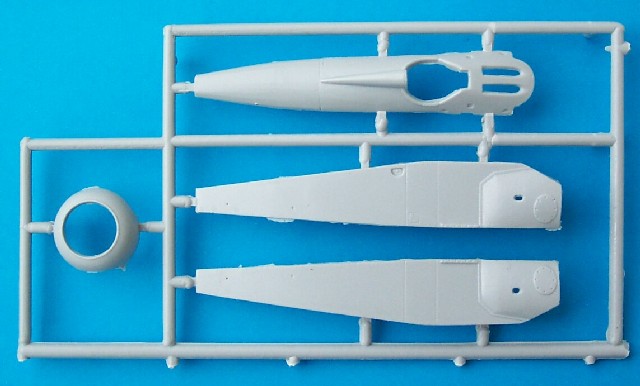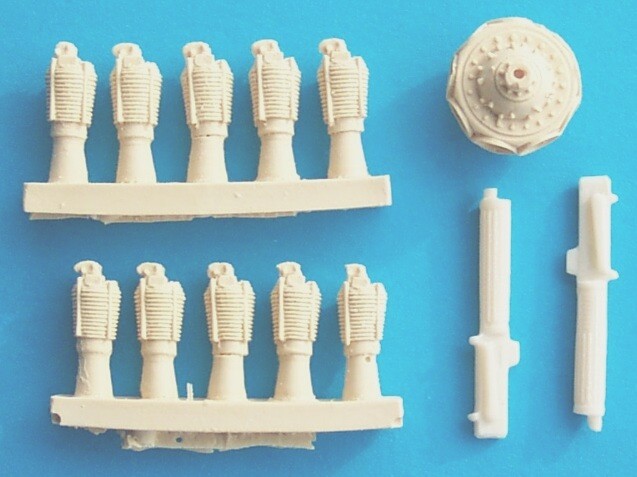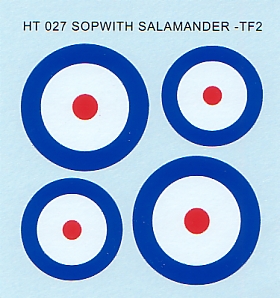S u m m a r y
|
| Catalogue
Number: |
Hi -Tech Sopwith Salamader
kit HT 017 |
| Scale: |
1/48 |
| Contents and Media: |
19 plastic and 23 pewter alloy
metal parts |
| Price: |
USD$44.96 from Squadron.com |
| Review Type: |
First Look |
| Advantages: |
Ultra thin decals, photo etched
parts, good quality resin, accurate in outline. |
| Disadvantages: |
Poor packaging leads to damage. |
| Recommendation: |
Recommended |
Reviewed by Robert Baumgartner

Hi-Tech's 1/48 scale Sopwith
Salamander TF2 is available online from Squadron.com
The Sopwith TF2 Salamander came about as a result of the success
experienced by the armouring of the Sopwith TF1 (TF meaning Trench
Fighter). Armour plating was used for the construction of the forward
fuselage to allow the type to be used in the ground attack role.
Like the early Snipes, the first production Salamanders carried the
small fins and simple upper wing ailerons. Due to difficulties
concerning the aircrafts control, later aircraft had the balanced
ailerons fitted to the upper wings as well as the larger fin and rudder
assembly.
Hi-Tech’s kit allows for this and includes both early and late fittings.
One of the reasons for this is that many of the sprues are common to
their Sopwith Snipe release.
There are forty-two plastic parts contained on three sprues. The
moulding is quite good although a quick swipe with wet and dry paper can
be used to remove some surface irregularities.
The fuselage consists of two halves with a separate turtle deck.

Click the thumbnails below to view larger
images:
Inside these, the modeller uses the supplied plastic framework and
photo-etched pieces to build up the cockpit area. The latter consists of
the floorboards, wicker seat, rudder, handgrip, instrument panel and
seatbelts.
The wings are common to both this and Hi-Tech’s Snipe kit so the
modeller must make a few adjustments where necessary. These are pointed
out in the instructions and relate to the different ailerons.
Although the rib detail on the undersides of the flying surfaces is
subtle, the extra detail imparted on the topsides is grossly oversized.
Luckily a few swipes with the wet and dry paper will tone things down a
bit.
The trailing edges are good but on my example, a little hot water was
needed to straighten out one of the wing sections.
Hi-Tech supply a resin ten piece engine and this is superb. A few push
rods, supplied by the modeller, are all it takes to complete this nice
assembly.
Resin is also used for the Vickers guns and they too are of the same
high standard. P-e loading handles further enhance their look.
The other photo-etched pieces on the fret take care of the finer
details.
These items include the footsteps, control horns, cable entry/exit
reinforcements, propeller faceplate, etc.
One thing that needs special mention is the packaging. Unfortunately the
way this is done leads to breakages and other damage. The unprotected
p-e fret is left to swim around in the box with the equally unprotected
plastic sprues. Naturally plenty of damage to the p-e results.

The resin didn’t fair any better either with most of the detail being
snapped off the top of the cylinders.
Despite what the box says, the instructions are not “highly detailed”.
The sheet a nebulous guide as to where the various components go and it
is up to the builder to obtain more detailed references elsewhere.
Decals
A single aircraft is illustrated on the instruction sheet. This is
for a machine that wore one of the evaluation camouflage schemes.
Hi-Tech chose to illustrate it with balanced ailerons and late tail,
suggesting it was a later built machine flying at the Front.

One can however build the third prototype E5431 and still use the kit’s
decals. It also bore the experimental scheme but had the early simple
type ailerons and tail. Unfortunately it crashed before its camouflage
could be evaluated.
The decal sheet is well printed and the registration was excellent. The
very thin carrier film is praiseworthy and notice that the correct
differently sized roundels are supplied.
Credit to Hi-Tech for having the courage to produce a kit of this
often overlooked subject. The experimental camouflage scheme will make
this into an attractive display piece and should prove popular amongst
the modelling fraternity.
A kit of this type will always require a bit of extra work so the
builder must be prepared for this eventuality.
The only real downside is the packaging. Delicate p-e and resin must be
protected from the thrashing actions of the loose heavy plastic. Apart
from that the experienced modeller should enjoy the challenge of this
injection moulded Salamander.
Recommended
Thanks to
Squadron.com for the review sample.
Review and Images Copyright © 2005 by
Robert Baumgartner
Page Created 08 June, 2005
Last updated 07 June, 2005
Back to HyperScale Main Page
Back to Reviews Page
|
Home | What's
New | Features
| Gallery |
Reviews | Reference
| Forum
| Search